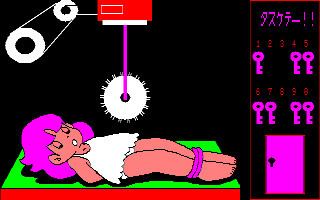 | ||
Similar Night Life, Tokyo Nampa Street, Jesus: Kyōfu no Bio Monst, Tenshitachi no Gogo, Angelus: Akuma no Fukuin | ||
Lolita Syndrome (ロリータ・シンドローム) is a Japanese adult computer game created by Enix and released on 31 October 1983 for the FM-7 and PC-8801 platforms. The game art was designed by Katsumi Mochizuki.
Contents
Plot
The game takes place within a house called "Maison Lolita" where underaged cartoon girls run around without clothes, and play games which involve cheating death. The game features depictions of human gore and underage children.
Gameplay
The player selects one of five rooms to enter, with each containing a different minigame.
Buzz saw room
A girl is strapped to a table, and a circular buzz saw is slowly moving towards her. The player must choose the correct key from ten keys in order to release the girl, and is limited to five guesses. After five incorrect guesses, the buzz saw slices the girl who explodes into a fountain of gore and dies; if the player is successful in freeing the girl, she takes off her clothes.
Human dart board room
A girl is strapped to a dart board, and the player is to toss darts at her. The player selects a series of darts which are randomly allocated by number; success is determined randomly by the computer depending on which number the player selects. If the player wins, the girl's clothing is removed; otherwise, the girl explodes into gore and dies.
Password room
A sleeping girl is lying on a bed, and the player must type a Japanese word in order to wake her up and have her take her clothes off. The game provides hints to the player.
Rock Paper Scissors room
The player plays a game of rock paper scissors against a girl, who removes a piece of her clothing each time the player wins.
Gallery room
The final room does not involve a game, but rather a gallery where the player can view pornographic images of underage cartoon girls.
Development
Prior to creating its well-known series of role playing games which include Dragon Quest and Star Ocean, Enix was a niche game publisher which became involved in the creation of pornographic games during the 1980s. Lolita Syndrome was the winning game of the second Hobby Program Contest sponsored by Enix.
An earlier game created by Enix in February 1983, Guest Mariko Hashimoto (マリちゃん危機一髪), similarly involves gore and pornographic imagery of underage girls, with the player protecting a girl named Mariko from people who throw knives at her, attach her to high-voltage batteries, or place her next to bombs.
